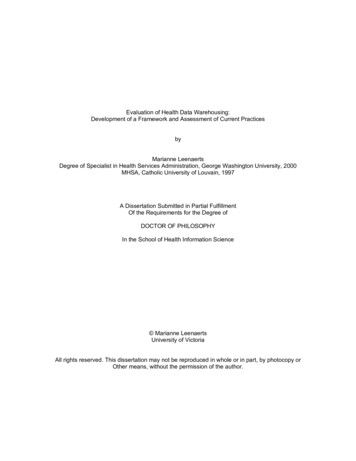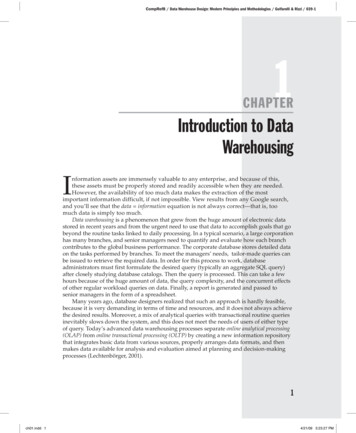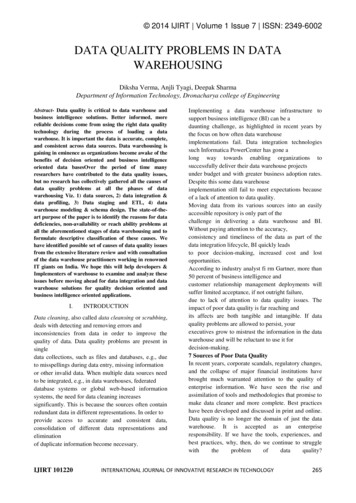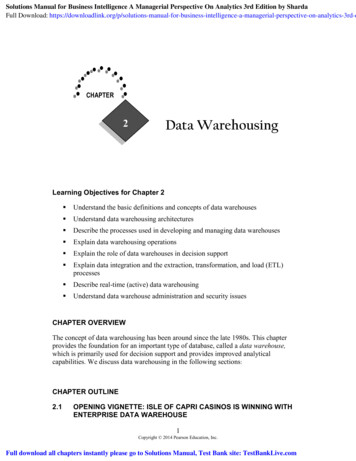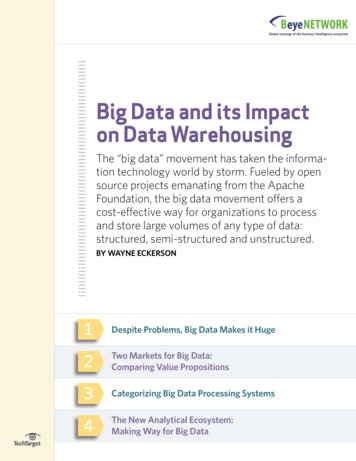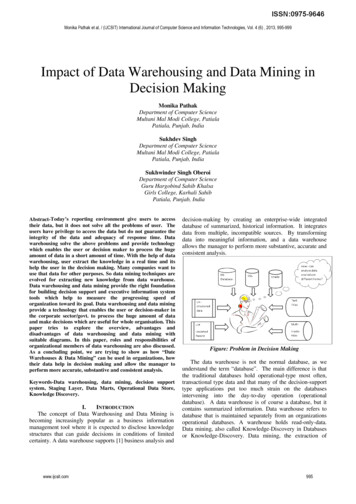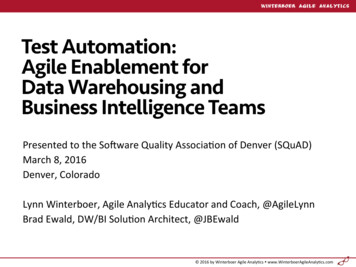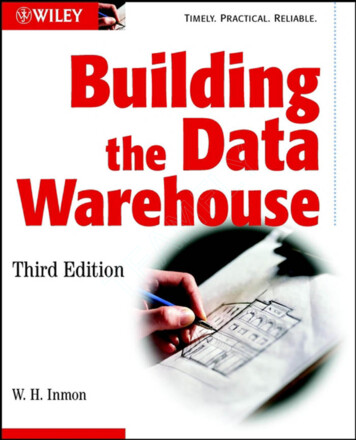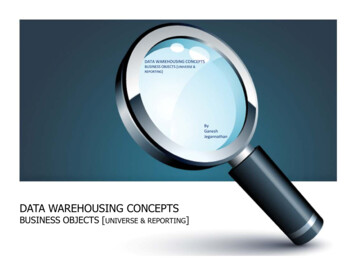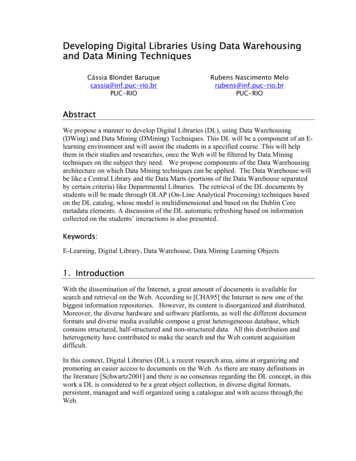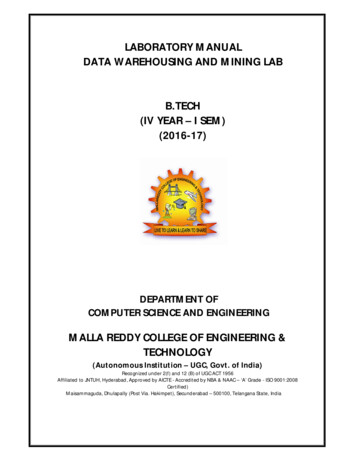
Transcription
LABORATORY MANUALDATA WAREHOUSING AND MINING LABB.TECH(IV YEAR – I SEM)(2016-17)DEPARTMENT OFCOMPUTER SCIENCE AND ENGINEERINGMALLA REDDY COLLEGE OF ENGINEERING &TECHNOLOGY(Autonomous Institution – UGC, Govt. of India)Recognized under 2(f) and 12 (B) of UGC ACT 1956Affiliated to JNTUH, Hyderabad, Approved by AICTE - Accredited by NBA & NAAC – ‘A’ Grade - ISO 9001:2008Certified)Maisammaguda, Dhulapally (Post Via. Hakimpet), Secunderabad – 500100, Telangana State, India
DEPARTMENT OF COMPUTER SCIENCE AND ENGINEERINGVision To acknowledge quality education and instill high patterns ofdiscipline making the students technologically superior and ethicallystrong which involves the improvement in the quality of life inhuman race.Mission To achieve and impart holistic technical education using the best ofinfrastructure, outstanding technical and teaching expertise toestablish the students into competent and confident engineers. Evolving the center of excellence through creative and innovativeteaching learning practices for promoting academic achievement toproduce internationally accepted competitive and world classprofessionals.
PROGRAMME EDUCATIONAL OBJECTIVES (PEOs)PEO1 – ANALYTICAL SKILLS1. To facilitate the graduates with the ability to visualize, gather information,articulate, analyze, solve complex problems, and make decisions. These areessential to address the challenges of complex and computation intensiveproblems increasing their productivity.PEO2 – TECHNICAL SKILLS2. To facilitate the graduates with the technical skills that prepare them forimmediate employment and pursue certification providing a deeperunderstanding of the technology in advanced areas of computer science andrelated fields, thus encouraging to pursue higher education and research basedon their interest.PEO3 – SOFT SKILLS3. To facilitate the graduates with the soft skills that include fulfilling the mission,setting goals, showing self-confidence by communicating effectively, having apositive attitude, get involved in team-work, being a leader, managing theircareer and their life.PEO4 – PROFESSIONAL ETHICSTo facilitate the graduates with the knowledge of professional and ethicalresponsibilities by paying attention to grooming, being conservative with style,following dress codes, safety codes, and adapting themselves to technologicaladvancements.
PROGRAM SPECIFIC OUTCOMES (PSOs)After the completion of the course, B. Tech Computer Science and Engineering, thegraduates will have the following Program Specific Outcomes:1. Fundamentals and critical knowledge of the Computer System:- Able toUnderstand the working principles of the computer System and its components ,Apply the knowledge to build, asses, and analyze the software and hardwareaspects of it .2. The comprehensive and Applicative knowledge of Software Development:Comprehensive skills of Programming Languages, Software process models,methodologies, and able to plan, develop, test, analyze, and manage thesoftware and hardware intensive systems in heterogeneous platformsindividually or working in teams.3. Applications of Computing Domain & Research: Able to use the professional,managerial, interdisciplinary skill set, and domain specific tools in developmentprocesses, identify the research gaps, and provide innovative solutions to them.
PROGRAM OUTCOMES (POs)Engineering Graduates will be able to:1. Engineering knowledge: Apply the knowledge of mathematics, science,engineering fundamentals, and an engineering specialization to the solutionof complex engineering problems.Problem analysis: Identify, formulate, review research literature, and analyzecomplex engineering problems reaching substantiated conclusions using firstprinciples of mathematics, natural sciences, and engineering sciences.3. Design / development of solutions: Design solutions for complex engineeringproblems and design system components or processes that meet thespecified needs with appropriate consideration for the public health andsafety, and the cultural, societal, and environmental considerations.4. Conduct investigations of complex problems: Use research-based knowledgeand research methods including design of experiments, analysis andinterpretation of data, and synthesis of the information to provide validconclusions.5. Modern tool usage: Create, select, and apply appropriate techniques,resources, and modern engineering and IT tools including prediction andmodeling to complex engineering activities with an understanding of thelimitations.6. The engineer and society: Apply reasoning informed by the contextualknowledge to assess societal, health, safety, legal and cultural issues and theconsequent responsibilities relevant to the professional engineering practice.7. Environment and sustainability: Understand the impact of the professionalengineering solutions in societal and environmental contexts, anddemonstrate the knowledge of, and need for sustainable development.8. Ethics: Apply ethical principles and commit to professional ethics andresponsibilities and norms of the engineering practice.9. Individual and team work: Function effectively as an individual, and as amember or leader in diverse teams, and in multidisciplinary settings.10. Communication: Communicate effectively on complex engineering activitieswith the engineering community and with society at large, such as, being ableto comprehend and write effective reports and design documentation, makeeffective presentations, and give and receive clear instructions.11. Projectmanagement and finance: Demonstrate knowledge andunderstanding of the engineering and management principles and applythese to one’s own work, as a member and leader in a team, to manageprojects and in multi disciplinary environments.12. Life- long learning: Recognize the need for, and have the preparation andability toengage in independent and life-long learning in the broadestcontext of technological change.2.
MALLA REDDY COLLEGE OF ENGINEERING &TECHNOLOGYMaisammaguda, Dhulapally Post, Via Hakimpet, Secunderabad – 500100DEPARTMENT OF COMPUTER SCIENCE AND ENGINEERINGGENERAL LABORATORY INSTRUCTIONS1. Students are advised to come to the laboratory at least 5 minutes before (to thestarting time), those who come after 5 minutes will not be allowed into the lab.2. Plan your task properly much before to the commencement, come prepared to the labwith the synopsis / program / experiment details.3. Student should enter into the laboratory with:a. Laboratory observation notes with all the details (Problem statement, Aim,Algorithm, Procedure, Program, Expected Output, etc.,) filled in for the lab session.b. Laboratory Record updated up to the last session experiments and other utensils (ifany) needed in the lab.c. Proper Dress code and Identity card.4. Sign in the laboratory login register, write the TIME-IN, and occupy the computersystem allotted to you by the faculty.5. Execute your task in the laboratory, and record the results / output in the labobservation note book, and get certified by the concerned faculty.6. All the students should be polite and cooperative with the laboratory staff, mustmaintain the discipline and decency in the laboratory.7. Computer labs are established with sophisticated and high end branded systems,which should be utilized properly.8. Students / Faculty must keep their mobile phones in SWITCHED OFF mode duringthe lab sessions.Misuse of the equipment, misbehaviors with the staff and systemsetc., will attract severe punishment.9. Students must take the permission of the faculty in case of any urgency to go out ; ifanybody found loitering outside the lab / class without permission during workinghours will be treated seriously and punished appropriately.10. Students should LOG OFF/ SHUT DOWN the computer system before he/she leavesthe lab after completing the task (experiment) in all aspects. He/she must ensure thesystem / seat is kept properly.Head of the DepartmentPrincipal
Department of CSEData Warehousing and Mining LabCOURSE NAME: DATA WAREHOUSING AND MINING LABCOURSE CODE: A70595COURSE OBJECTIVES:1.Learn how to build a data warehouse and query it (using open source tools likePentaho Data Integration Tool, Pentaho Business Analytics).2.Learn to perform data mining tasks using a data mining toolkit (such as open sourceWEKA).3.Understand the data sets and data preprocessing.4.Demonstrate the working of algorithms for data mining tasks such association rule mining,classification, clustering and regression.5.Exercise the data mining techniques with varied input values for different parameters.6.To obtain Practical Experience Working with all real data sets.7.Emphasize hands-on experience working with all real data sets.COURSE OUTCOMES:1.Ability to understand the various kinds of tools.2.Demonstrate the classification, clustering and etc. in large data sets.3.Ability to add mining algorithms as a component to the exiting tools.4.Ability to apply mining techniques for realistic data.MAPPING OF COURSE OUTCOMES WITH PROGRAM OUTCOMES:COURSE OUTCOMES Ability to add mining algorithms asa component to the exiting tools. Ability to apply mining techniquesfor realistic data.MRCETPO1PO2PO3 PO4PO5PO6PO7PO8P09PO10PO11 Page 1
Data Warehousing and Mining LabDepartment of CSEDATA WAREHOUSING AND MINING LAB- INDEXS.NoExperiment NamePage No1Unit-I Build Data Warehouse and Explore WEKA032Unit-II Perform data preprocessing tasks and Demonstrateperforming association rule mining on data sets593Unit-III Demonstrate performing classification on data sets714Unit-IV Demonstrate performing clustering on data sets955Unit-V Demonstrate performing Regression on data sets1046Task 1: Credit Risk Assessment. Sample Programs usingGerman Credit Data1167Task 2: Sample Programs using Hospital Management System1378Beyond the Syllabus -Simple Project on Data Preprocessing139MRCETPage 2
Data Warehousing and Miining LabDeparartment of CSEUnit-I Buildld Data Warehouse and Explore WEKAA. Build Data Warehouse/Daata Mart (using open source tools likee Pentaho DataIntegration Tool, Pentaho B usiness Analytics; or other data wareheh ouse tools likeMicrosoft-SSIS,Informatica,B, B usiness Objects,etc.,)A.(i) Identify source tables andnd populate sample data.The data warehouse contains 4 tabtables:1. Date dimension: containss every single date from 2006 to 2016.2. Customer dimension: contntaains 100 customers. To be simple we’ll make it type 1 so wedon’t create a new row foror each change.3. Van dimension: contains 20 vans. To be simple we’ll make it type 1 so wwee don’t create anew row for each change.4. Hire fact table: contains 101000 hire transactions since 1st Jan 2011. It is a ddaaily snapshot facttable so that every day wee insert 1000 rows into this fact table. So over timime we can trackthe changes of total bill, vavan charges, satnav income, etc.Create the source tables and popopulate themSo now we are going to create thehe 3 tables in HireBase database: Customer, Van,a Hire. Thenn, andwe populate them.First I’ll show you how it looooks when it’s done:MRCETr3
Data Warehousing and Miining LabDeparartment of CSECustomer table:Van table:Hire table:MRCETPage 4
Data Warehousing and Mining LabDepartment of CSEAnd here is the script to create and populate them:-- Create databasecreate database HireBasegouse HireBasego-- Create customer tableif exists (select * from sys.tables where name 'Customer')drop table Customergocreate table Customer( CustomerId varchar(20) not null primary key,CustomerName varchar(30), DateOfBirth date, Town varchar(50),TelephoneNo varchar(30), DrivingLicenceNo varchar(30), Occupation varchar(30))go-- Populate Customertruncate table Customergodeclare @i int, @si varchar(10), @startdate dateset @i 1while @i 100beginset @si right('0' CONVERT(varchar(10), @i),2)insert into Customer( CustomerId, CustomerName, DateOfBirth, Town, TelephoneNo, DrivingLicenceNo,Occupation)values( 'N' @si, 'Customer' @si, DATEADD(d,@i-1,'2000-01-01'), 'Town' @si, 'Phone' @si,'Licence' @si, 'Occupation' @si)set @i @i 1endgoselect * from Customer-- Create Van tableif exists (select * from sys.tables where name 'Van')drop table VangoMRCETpage 5
Data Warehousing and Mining LabDepartment of CSEcreate table Van( RegNo varchar(10) not null primary key,Make varchar(30), Model varchar(30), [Year] varchar(4),Colour varchar(20), CC int, Class varchar(10))go-- Populate Van tabletruncate table Vangodeclare @i int, @si varchar(10)set @i 1while @i 20beginset @si convert(varchar, @i)insert into Van( RegNo, Make, Model, [Year], Colour, CC, Class)values( 'Reg' @si, 'Make' @si, 'Model' @si,case @i%4 when 0 then 2008 when 1 then 2009 when 2 then 2010 when 3 then 2011 end,case when @i%5 3 then 'White' else 'Black' end,case @i%3 when 0 then 2000 when 1 then 2500 when 2 then 3000 end,case @i%3 when 0 then 'Small' when 1 then 'Medium' when 2 then 'Large' end)set @i @i 1endgoselect * from Van-- Create Hire tableif exists (select * from sys.tables where name 'Hire')drop table Hiregocreate table Hire( HireId varchar(10) not null primary key,HireDate date not null,CustomerId varchar(20) not null,RegNo varchar(10), NoOfDays int, VanHire money, SatNavHire money,Insurance money, DamageWaiver money, TotalBill money)goMRCETpage 6
Data Warehousing and Miining LabDeparartment of CSE-- Populate Hire tabletruncate table Hiregodeclare @i int, @si varchar(10), @DaysFrom1stJan int, @CustomerId int, @RegNegNo int, @mi intset @i 1while @i 1000beginset @si right('000' convert(varcarchar(10), @i),4) -- string of iset @DaysFrom1stJan (@i-1)%)%200 --The Hire Date is derived from i moduloo 200set @CustomerId (@i-1)%100 0 1 --The CustomerId is derived from i modulo 100set @RegNo (@i-1)%20 1 --ThThe Van RegNo is derived from i modulo 20set @mi (@i-1)%3 1 --i modulul o 3insert into Hire (HireId, HireDatete, CustomerId, RegNo, NoOfDays, VanHire, SatatNavHire,Insurance, DamageWaiver, TotalBBill)lvalues ('H' @si, DateAdd(d, @DDaysFrom1stJan, '2011-01-01'),left('N0' CONVERT(varchar(10)0),@CustomerId),3), 'Reg' CONVERT(varchar(1r(10), @RegNo),@mi, @mi*100, @mi*10, @mi*i*20, @mi*40, @mi*170)set @i 1endgoselect * from HireCreate the Data WarehouseseSo now we are going to createe the 3 dimension tables and 1 fact table in ththee data warehouse:DimDate, DimCustomer, DimVanan and FactHire. We are going to populate thee 3 dimensions butwe’ll leave the fact table empty.o populate the facty. The purpose of this article is to show how ttotable using SSIS.First I’ll show you how it looooks when it’s done:MRCETPa ge 7
Data Warehousing and Miining LabDeparartment of CSEDate Dimension:Customer Dimension:Van Dimension:MRCETpage 8
Data Warehousing and Mining LabDepartment of CSEAnd then we do it. This is the script to create and populate those dim and fact tables:-- Create the data warehousecreate database TopHireDWgouse TopHireDWgo-- Create Date Dimensionif exists (select * from sys.tables where name 'DimDate')drop table DimDategocreate table DimDate( DateKey int not null primary key,[Year] varchar(7), [Month] varchar(7), [Date] date, DateString varchar(10))go-- Populate Date Dimensiontruncate table DimDategodeclare @i int, @Date date, @StartDate date, @EndDate date, @DateKey int,@DateString varchar(10), @Year varchar(4),@Month varchar(7), @Date1 varchar(20)set @StartDate '2006-01-01'set @EndDate '2016-12-31'set @Date @StartDateinsert into DimDate (DateKey, [Year], [Month], [Date], DateString)values (0, 'Unknown', 'Unknown', '0001-01-01', 'Unknown') --The unknown rowwhile @Date @EndDatebeginset @DateString convert(varchar(10), @Date, 20)set @DateKey convert(int, replace(@DateString,'-',''))set @Year left(@DateString,4)set @Month left(@DateString, 7)insert into DimDate (DateKey, [Year], [Month], [Date], DateString)values (@DateKey, @Year, @Month, @Date, @DateString)set @Date dateadd(d, 1, @Date)endgoselect * from DimDateMRCETpage 9
Data Warehousing and Mining LabDepartment of CSE-- Create Customer dimensionif exists (select * from sys.tables where name 'DimCustomer')drop table DimCustomergocreate table DimCustomer( CustomerKey int not null identity(1,1) primary key,CustomerId varchar(20) not null,CustomerName varchar(30), DateOfBirth date, Town varchar(50),TelephoneNo varchar(30), DrivingLicenceNo varchar(30), Occupation varchar(30))goinsert into DimCustomer (CustomerId, CustomerName, DateOfBirth, Town, TelephoneNo,DrivingLicenceNo, Occupation)select * from HireBase.dbo.Customerselect * from DimCustomer-- Create Van dimensionif exists (select * from sys.tables where name 'DimVan')drop table DimVangocreate table DimVan( VanKey int not null identity(1,1) primary key,RegNo varchar(10) not null,Make varchar(30), Model varchar(30), [Year] varchar(4),Colour varchar(20), CC int, Class varchar(10))goinsert into DimVan (RegNo, Make, Model, [Year], Colour, CC, Class)select * from HireBase.dbo.Vangoselect * from DimVan-- Create Hire fact tableif exists (select * from sys.tables where name 'FactHire')drop table FactHiregoMRCETpage 10
Data Warehousing and Mining LabDepartment of CSEcreate table FactHire( SnapshotDateKey int not null, --Daily periodic snapshot fact tableHireDateKey int not null, CustomerKey int not null, VanKey int not null, --Dimension KeysHireId varchar(10) not null, --Degenerate DimensionNoOfDays int, VanHire money, SatNavHire money,Insurance money, DamageWaiver money, TotalBill money)goselect * from FactHireA.(ii). Design multi-demesional data models namely Star, Snowflake and FactConstellation schemas for any one enterprise (ex. Banking,Insurance, Finance,Healthcare, manufacturing, Automobiles,sales etc).Ans:Schema DefinitionMultidimensional schema is defined using Data Mining Query Language (DMQL). The twoprimitives, cube definition and dimension definition, can be used for defining the data warehousesand data marts.Star Schema Each dimension in a star schema is represented with only one-dimension table. This dimension table contains the set of attributes. The following diagram shows the sales data of a company with respect to the fourdimensions, namely time, item, branch, and location. There is a fact table at the center. It contains the keys to each of four dimensions. The fact table also contains the attributes, namely dollars sold and units sold.MRCETPage 11
Data Warehousing and Mining LabDepartment of CSESnowflake Schema Some dimension tables in the Snowflake schema are normalized. The normalization splits up the data into additional tables. Unlike Star schema, the dimensions table in a snowflake schema is normalized. Forexample, the item dimension table in star schema is normalized and split into twodimension tables, namely item and supplier table. Now the item dimension table contains the attributes item key, item name, type, brand,and supplier-key. The supplier key is linked to the supplier dimension table. The supplier dimension tablecontains the attributes supplier key and supplier type.MRCETPage 12
Data Warehousing and Mining LabDepartment of CSEFact Constellation Schema A fact constellation has multiple fact tables. It is also known as galaxy schema. The following diagram shows two fact tables, namely sales and shipping. The sales fact table is same as that in the star schema. The shipping fact table has the five dimensions, namely item key, time key, shipper key,from location, to location. The shipping fact table also contains two measures, namely dollars sold and units sold. It is also possible to share dimension tables between fact tables. For example, time, item,and location dimension tables are shared between the sales and shipping fact table.MRCETPage 13
Data Warehousing and Mining LabDepartment of CSEA.(iii) Write ETL scripts and implement using data warehouse tools.Ans:ETL comes from Data Warehousing and stands for Extract-Transform-Load. ETL covers a processof how the data are loaded from the source system to the data warehouse. Extraction–transformation–loading (ETL) tools are pieces of software responsible for the extraction of datafrom several sources, its cleansing, customization, reformatting, integration, and insertion into adata warehouse.Building the ETL process is potentially one of the biggest tasks of building a warehouse; it iscomplex, time consuming, and consumes most of data warehouse project’s implementation efforts,costs, and resources.Building a data warehouse requires focusing closely on understanding three main areas:1. Source Area- The source area has standard models such as entity relationship diagram.2. Destination Area- The destination area has standard models such as star schema.3. Mapping Area- But the mapping area has not a standard model till now.MRCETpage14
Data Warehousing and Mining LabDepartment of CSEAbbreviations ETL-extraction–transformation–loadingDW-data warehouseDM- data martOLAP- on-line analytical processingDS-data sourcesODS- operational data storeDSA- data staging areaDBMS- database management systemOLTP-on-line transaction processingCDC-change data captureSCD-slowly changing dimensionFCME- first-class modeling elementsEMD-entity mapping diagramDSA-data storage areaETL Process:ExtractThe Extract step covers the data extraction from the source system and makes it accessible forfurther processing. The main objective of the extract step is to retrieve all the required data fromthe source system with as little resources as possible. The extract step should be designed in a waythat it does not negatively affect the source system in terms or performance, response time or anykind of locking.There are several ways to perform the extract: Update notification - if the source system is able to provide a notification that a record has beenchanged and describe the change, this is the easiest way to get the data.Incremental extract - some systems may not be able to provide notification that an update hasoccurred, but they are able to identify which records have been modified and provide an extract ofsuch records. During further ETL steps, the system needs to identify changes and propagate itdown. Note, that by using daily extract, we may not be able to handle deleted records properly.Full extract - some systems are not able to identify which data has been changed at all, so a fullextract is the only way one can get the data out of the system. The full extract requires keeping acopy of the last extract in the same format in order to be able to identify changes. Full extracthandles deletions as well.MRCETPage 15
Data Warehousing and Mining LabDepartment of CSETransformThe transform step applies a set of rules to transform the data from the source to the target. Thisincludes converting any measured data to the same dimension (i.e. conformed dimension) using thesame units so that they can later be joined. The transformation step also requires joining data fromseveral sources, generating aggregates, generating surrogate keys, sorting, deriving new calculatedvalues, and applying advanced validation rules.LoadDuring the load step, it is necessary to ensure that the load is performed correctly and with as littleresources as possible. The target of the Load process is often a database. In order to make the loadprocess efficient, it is helpful to disable any constraints and indexes before the load and enablethem back only after the load completes. The referential integrity needs to be maintained by ETLtool to ensure consistency.ETL method – nothin’ but SQLETL as scripts that can just be run on the database.These scripts must be re-runnable: they shouldbe able to be run without modification to pick up any changes in the legacy data, and automaticallywork out how to merge the changes into the new schema.In order to meet the requirements, my scripts must:1. INSERT rows in the new tables based on any data in the source that hasn’t already been created inthe destination2. UPDATE rows in the new tables based on any data in the source that has already been inserted inthe destination3. DELETE rows in the new tables where the source data has been deletedNow, instead of writing a whole lot of INSERT, UPDATE and DELETE statements, I thought“surely MERGE would be both faster and better” – and in fact, that has turned out to be the case.By writing all the transformations as MERGE statements, I’ve satisfied all the criteria, while alsomaking my code very easily modified, updated, fixed and rerun. If I discover a bug or a changein requirements, I simply change the way the column is transformed in the MERGE statement, andre-run the statement. It then takes care of working out whether to insert, update or delete each row.My next step was to design the architecture for my custom ETL solution. I went to the dba with thefollowing design, which was approved and created for me:1.2.3.4.create two new schemas on the new 11g database: LEGACY and MIGRATEtake a snapshot of all data in the legacy database, and load it as tables in the LEGACY schemagrant read-only on all tables in LEGACY to MIGRATEgrant CRUD on all tables in the target schema to MIGRATE.MRCETPage 16
Data Warehousing and Mining LabDepartment of CSEFor example, in the legacy database we have a table:LEGACY.BMS PARTIES(par idNUMBERPRIMARY KEY,par domainVARCHAR2(10) NOT NULL,par first nameVARCHAR2(100) ,par last nameVARCHAR2(100),par dobDATE,par business name VARCHAR2(250),created byVARCHAR2(30) NOT NULL,creation dateDATENOT NULL,last updated by VARCHAR2(30),last update date DATE)In the new model, we have a new table that represents the same kind of information:NEW.TBMS PARTY(party idNUMBER(9)party type codePRIMARY KEY,VARCHAR2(10) NOT NULL,first nameVARCHAR2(50),surnameVARCHAR2(100),MRCETpage 17
Data Warehousing and Mining Labdate of birthDATE,business nameVARCHAR2(300),db created byVARCHAR2(50) NOT NULL,db created onDATEDEFAULT SYSDATE NOT NULL,db modified byVARCHAR2(50),db modified onDATE,version idDepartment of CSENUMBER(12) DEFAULT 1 NOT NULL)This was the simplest transformation you could possibly think of – the mapping from one to theother is 1:1, and the columns almost mean the same thing.The solution scripts start by creating an intermediary table:MIGRATE.TBMS PARTY(old par idparty idNUMBERNUMBER(9)party type codePRIMARY KEY,NOT NULL,VARCHAR2(10) NOT NULL,first nameVARCHAR2(50),surnameVARCHAR2(100),date of birthDATE,business nameVARCHAR2(300),db created byVARCHAR2(50),MRCETPage 18
Data Warehousing and Mining Labdb created onDATE,db modified byVARCHAR2(50),db modified onDATE,deletedDepartment of CSECHAR(1))The second step is the E and T parts of “ETL”: I query the legacy table, transform the data rightthere in the query, and insert it into the intermediary table. However, since I want to be able to rerun this script as often as I want, I wrote this as a MERGE statement:MERGE INTO MIGRATE.TBMS PARTY destUSING (SELECT par idpar idAS old par id,AS party id,CASE par domainWHEN 'P' THEN 'PE' /*Person*/WHEN 'O' THEN 'BU' /*Business*/ENDAS party type code,par first nameAS first name,par last nameAS surname,par dobAS date of birth,par business name AS business name,MRCETpage 19
Data Warehousing and Mining Labcreated byAS db created by,creation dateAS db created on,last updated by AS db modified by,last update date AS db modified onFROM LEGACY.BMS PARTIES sWHERE NOT EXISTS (SELECT nullFROM MIGRATE.TBMS PARTY dWHERE d.old par id s.par idAND (d.db modified on s.last update dateOR (d.db modified on IS NULLAND s.last update date IS NULL)))) srcON (src.OLD PAR ID dest.OLD PAR ID)WHEN MATCHED THEN UPDATE SETparty id src.party id,party type code src.party type code ,first name src.first name,Department of CSE
Data Warehousing and Mining Labsurname src.surnameDepartment of CSE,date of birth src.date of birth ,business name src.business name ,db created by src.db created by ,db created on src.db created on ,db modified by src.db modified by ,A.(iv) Perform Various OLAP operations such slice, dice, roll up, drill up and pivot.Ans:OLAP OPERATIONSOnline Analytical Processing Server (OLAP) is based on the multidimensional data model. Itallows managers, and analysts to get an insight of the information through fast, consistent, andinteractive access to information.OLAP operations in multidimensional data.Here is the list of OLAP operations: Roll-up Drill-down Slice and dice Pivot (rotate)Roll-upRoll-up performs aggregation on a data cube in any of the following ways: By climbing up a concept hierarchy for a dimension By dimension reductionThe following diagram illustrates how roll-up works.MRCETPage 21
Data Warehousing and Mining LabDepartment of CSE Roll-up is performed by climbing up a concept hierarchy for the dimension location. Initially the concept hierarchy was "street city province country". On rolling up, the data is aggregated by ascending the location hierarchy from the level ofcity to the level of country. The data is grouped into cities rather than countries. When roll-up is performed, one or more dimensions from the data cube are removed.Drill-downDrill-down is the reverse operation of roll-up. It is performed by either of the following ways: By stepping down a concept hierarchy for a dimension By introducing a new dimension.The following diagram illustrates how drill-down works:MRCETPage 22
Data Warehousing and Mining LabDepartment of CSE Drill-down is performed by stepping down a concept hierarchy for the dimension time. Initially the concept hierarchy was "day month quarter year." On drilling down, the time dimension is descended from the level of quarter to the level ofmonth. When drill-down is performed, one or more dimensions from the data cube are added. It navigates the data from less detailed data to highly detailed data.SliceThe slice operation selects one particular dimension from a given cube and provides a new subcube. Consider the following diagram that
Pentaho Data Integration Tool, Pentaho Business Analytics). 2. Learn to perform data mining tasks using a data mining toolkit (such as open source WEKA). 3. Understand the data sets and data preprocessing. 4. Demonstrate the working of algorithms for data mining tasks such association rule mining, classification, clustering and regression.
